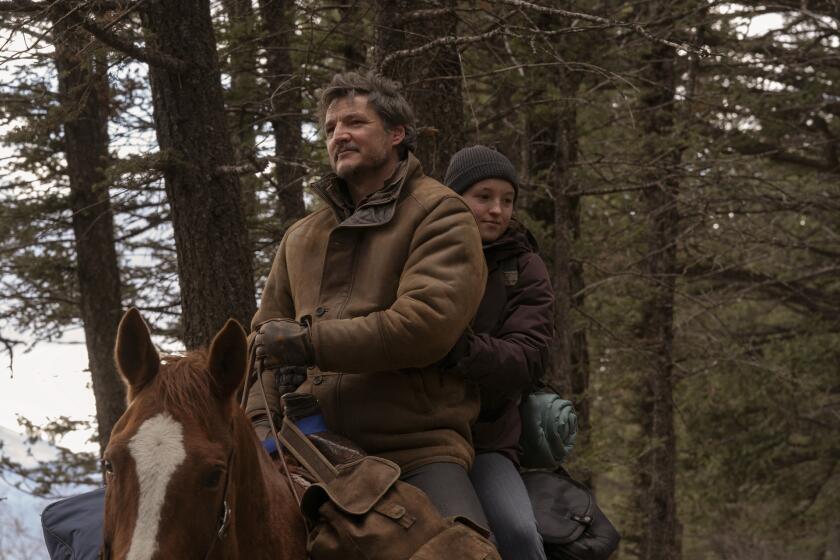WOMAN’S BUILDING AWARDS : PICTURE FOR WOMEN ARTISTS BRIGHTER
- Share via
As the Woman’s Building art center prepares to honor 11 women on Sunday who have made “significant contributions” to all the arts in Southern California, it seems that some local women working in the visual arts are happier about their status than they were about this time last year.
The three of this year’s sixth annual Vesta Awards brunch, named after the Roman goddess of the hearth, “is pretty much what it always is,” says Woman’s Building spokeswoman Terry Wolverton. “And that’s giving community recognition to these women who have contributed so much to the community, particularly the cultural community.”
Last year’s Vesta Awards, however, came shortly after the Women Artists Visibility Event (WAVE), a nationwide protest against sexual discrimination in the visual-arts world. And unwittingly, awards guest speaker Judy Chicago brought the WAVE theme into the awards ceremony as she spoke to the issue of women in the art world.
Chicago, a feminist artist who came to prominence in the 1960s, told luncheon guests that women artists of the ‘80s were experiencing the same degree of discrimination that she had encountered decades ago.
“In the ‘60s and ‘70s, I couldn’t breathe, I couldn’t be myself as a woman artist,” Chicago said. “Today I can. But that change is only significant if around us exists a historical context and base for the change. . . . Today that base is being eroded as fast as we built it.”
Chicago’s observations seemed to jibe with those of WAVE organizers, members of the Women’s Caucus for Art, a national advocacy group. These activists charged last year that although nationally 38% of professional artists were women, their work was being shown in mainstream art institutions only 10% of the time. Local WAVE participants had found that neither the long-established Los Angeles County Museum of Art nor the then-3-year-old Museum of Contemporary Art had ever had a major retrospective exhibit of a female artist’s work.
However, locally, the WAVE demonstration sees to have generated some positive results.
No new research has been conducted to analyze the percentage of women artists’ representation in local museums, says Lucy Blake-Elahi, artist and president of the Southern California chapter of the women’s caucus. “But as far as the County Museum and MOCA and their willingness and preparedness to work with us is concerned, the change has been tremendous.”
Blake-Elahi says that she and several members of the local caucus chapter have met with curators at both museums since the WAVE. “There is a commitment at least to communicate with women artists, especially on the part of Mary Jane Jacob (MOCA’s chief curator). And Howard Fox (curator of contemporary art at the County Museum of Art) is willing to discuss the issue.” Curator Jacob said MOCA is exhibiting a solo retrospective exhibit of artist Elizabeth Murray’s paintings and that in the “very near future, we’ll be proposing one-person shows” by women artists, and “working on some group exhibits in which women figure not only prominently but essentially.
“We want to make sure that women are constantly in our programming.”
Curator Fox said that a discussion of whether the County Museum of Art would organize a major solo exhibition of a women artist’s work was premature. However, he said he has encouraged local caucus members to investigate the possibility of designing a program about the history of women in art with the County Museum of Art’s educational department.
Sunday’s Vesta Awards ceremony, a fund-raiser for the Woman’s Building, will be held from noon-3 p.m. at the downtown Westin Bonaventure Hotel. The women to be honored are:
Pop singer and activist Holly Near; veteran local artist Helen Lundeberg; writer Jane Wagner, who collaborates with comedian Lily Tomlin; actress Victoria Ann-Lewis; Los Angeles Times film critic Sheila Benson; performance artist Nancy Buchanan; attorney Susan A. Grode; architect Brenda A. Levin; architectural scholar and writer Esther McCoy; dancer-choreographer Nobuko Miyamoto, and Didi Daniels Peters, one of the first black women television producers in the country.
More to Read
The biggest entertainment stories
Get our big stories about Hollywood, film, television, music, arts, culture and more right in your inbox as soon as they publish.
You may occasionally receive promotional content from the Los Angeles Times.










